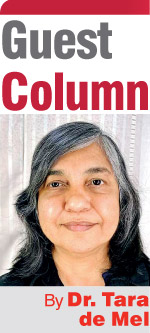Friday Jan 02, 2026
Friday Jan 02, 2026
Wednesday, 23 June 2021 00:00 - - {{hitsCtrl.values.hits}}

What we need to repeatedly remind ourselves is that Singapore metamorphosed into what it is today for one reason, i.e. that nation was built on a very solid and robust bedrock – namely the foundation of education. The leaders of that country led by LKY invested heavily in making education the most important currency of that country. Any current or aspiring future leader of this country should always remember this – Pic by Shehan Gunasekara
 Discussions on English medium education have surfaced, once again. Every few years, or if ever a government decides on touching this topic, rumblings begin on the merits or demerits of such an initiative.
Discussions on English medium education have surfaced, once again. Every few years, or if ever a government decides on touching this topic, rumblings begin on the merits or demerits of such an initiative.
It’s perhaps pertinent to trace events from recent history.
Rewind to the Education Reforms of 1998
The emphasis placed on improving English education was unambiguous and remained consistent.
In primary school the thrust was on Activity Based Oral English (ABOE) coupled with Conversational English. In the secondary school, it was to teach selected subjects in English whilst emphasising Conversational and General English in the Advanced Level.
In addition, there was the option to have English medium classes which allowed Sinhala, Tamil and Muslim students to learn in one class from young days, allowing greater integration between communities. A parallel initiative with the same aim was to initiate special Amity Schools for students of all three communities.
Criticisms and allowing choice
One main criticism levelled against English medium education was that children should learn in the mother tongue during their formative years. This was an opinion of one section of people whilst others promoted exposure to two languages (mother tongue and a second language) during formative years based on newer neuroscientific discoveries on brain growth during early years. (https://www.idra.org/resource-center/brain-development-and-mastery-of-language-in-the-early-childhood-years/).
The other objection raised was that the Constitution prohibited the use of English as a medium of instruction. This was while all international schools and some private and even Government schools had English medium instruction available as an option. What the Constitution actually says in Article 21. (1): ‘A person shall be entitled to be educated through the medium of either of the National Languages’.
It doesn’t mean that the choice of being educated in another language is prohibited by the Constitution, i.e. there is no impediment to providing English medium instructions at the primary school. All that was proposed by enabling English medium education was allowing the choice of English medium education and establishing the resources to facilitate same. Nobody advocated making English medium education mandatory while jettisoning the national languages.
Despite the leadership the then President gave to the English education program, and indeed to the entire Education Reform agenda, the obstacles posed by selected groups were largely political and often non-substantial.
Demand for English education
Meanwhile, the demand for English education from parents was growing apace. Large numbers of parents were left disappointed that their children couldn’t access English medium education, and therefore were considered not eligible for attractive employment opportunities after leaving school.
Those with means applied to international schools and some to private schools, but the large majority were left without options. Tuition masters swiftly began to supply what was in demand, since government schools didn’t offer what was sought.
Meanwhile, international schools which were registered as BOI companies (and still are), began to mushroom. What began with a total of about 100 such schools, now stands at nearly 500, bearing ample testimony to this demand.
Proof of Concept
It’s interesting to recall how during 1998-1999 it became necessary to ‘prove’ that there was indeed such a demand for English education. This was done by administering a simple questionnaire to parents of students attending about 100 schools in about 10 districts. They were asked if they were favourable if the option to study selected subjects in the English medium was offered to their children.
The large majority said ‘Yes’ and when asked for reasons they gave the following: ability to face interviews confidently, converse with those in higher socio-economic brackets, to apply for overseas placements and to secure a ‘good job’ when leaving school.
Such ‘Proof of Concept’ became necessary to get the Cabinet of Ministers on board. Apart from about five Ministers, the rest were either sceptical, critical or totally against the idea. Interestingly but not unexpectedly, some of the Ministers who opposed the idea already had children attending private or international schools which were teaching in English. And those children were destined to either seek jobs in the corporate sector or to head overseas for further education, eventually.
Looking back, what’s most interesting is that it took the daughter of a former Prime Minister who implemented a ‘Sinhala Only’ policy, to even start taking baby-steps towards undoing the harm done by her father decades before that.
Recently Dr. Mahim Mendis wrote ‘…Solomon West Ridgeway Dias Bandaranaike (SWRD), benefitted from the Western Protestant ethic at S. Thomas’ College, Mt Lavinia, and the University of Oxford. As a politician, SWRD became the father of the Sinhala Only Act, while knowing well that this policy would deprive the ordinary people, the model of education that made him a polished personality during that time.’ (https://island.lk/why-this-shamelessness/)
In promoting the policy, President Kumaratunga took a bold step and had the courage to face significant political opposition. The team entrusted with implementing the policy had the determination to transcend multiple hurdles since there was backing by the Head of State.
‘Lack of teachers’
The famous argument on why this proposal wouldn’t work was the issue of ‘lack of teachers’ proficient to teach English. There were even suggestions to bring trainers from overseas. These poorly-thought-out suggestions were made whilst excellent teacher training institutions existed (and still exist) in Sri Lanka.
The four National Colleges of Education dedicated for English education from which about 600 English teachers pass out annually, the 30 Regional English Support Centres (RESC) distributed across every district, University English Language Teaching Units (ELTU) affiliated to Departments of English in Universities, and of course the premier institution mandated to train teachers, the National Institute of Education (NIE). There was no credible way that an argument such as ‘where can we find trained teachers?’ could hold.
The Task Force for English at that time had experts on the subject and there was excellent support from university academics. But when governments changed in 2005 the enthusiasm dipped and gradually implementation slowed.
Fast forward to 2021
The same discussions are happening more than two decades later. More than 20 batches of students have left school since 1998. Political and other leaders have come and gone, and most of them have been able to give their own children an English medium education in school and university. They had the means and hence the choice.
Private and international schools and English tuition masters continue to flourish, levying fees from students who are denied English medium education in Government schools. Most of these international school teachers are also from Sri Lanka, but they receive intensive training from experienced trainers, again from Sri Lanka.
The current Government, which promised to renew English teaching and also English medium education, has again shelved plans. Once again, the same anti-English education lobby of two decades ago has won the battle. It’s interesting how the same wheel turns, 20 years later.
Today’s context
Although general enthusiasm on teacher training in English has lost its vigour, and there appears to be less energy, the same institutional arrangements remain.
The current staff at the NIE and the Ministry still have interest to renew previous efforts. They too believe that the only way to leapfrog into a situation where English proficiency is accessible to ALL students and to not just a few children with means, is to keep training teachers over and over again, using modern material and audio-visual methods. Most of them believe that Sri Lanka has the capacity to train teachers in English teaching, on par with those with overseas experiences.
Emulating Singapore
Singapore’s founding father Lee Kuan Yew (LKY) transformed an insignificant port city into a model nation state. LKY’s actions were firmly grounded on the principle that he should share with the people of Singapore, what he himself benefited from, by creating a level playing field for all Singaporeans.
Like SWRD who was educated at Oxford, LKY had his higher education at the University of Cambridge, albeit 24 years later. In his book ‘My Lifelong Challenge: Singapore’s Bilingual Journey’ (https://corporate.sph.com.sg/system/assets/729/kfcFzfff_LKY%20bilingual%20book%20summary.pdf), LKY mentions the challenges the Education Ministry faced in 1975. How Chinese-medium schools existed for a decade after the policy was introduced, and how teachers had to painfully switch from teaching in Chinese to teaching in English, and how students had to transit from a Chinese medium of instruction to English, almost overnight.
Dr. Mahim Mendis’s recent article then reminds us, ‘…at the National Day Rally of 1986, LKY claimed that he was “…a proud man that day”… For the first time since Singapore’s independence, 21 years earlier, the Master of Ceremonies for the event did not have to use three languages – Chinese, Malay and Tamil – to lead the audience, as finally, English had become a language understood by all Singaporeans..’
Referencing the success of that tiny nation state is intentional. Today it’s almost a fashion to want to emulate Singapore in every way. Leaders of our Governments are quoted as saying that Sri Lanka ‘must become another Singapore’. What we need to repeatedly remind ourselves is that Singapore metamorphosed into what it is today for one reason, i.e. that nation was built on a very solid and robust bedrock – namely the foundation of education. The leaders of that country led by LKY invested heavily in making education the most important currency of that country.
Any current or aspiring future leader of this country should always remember this.
(The writer is former Secretary, Ministry of Education)